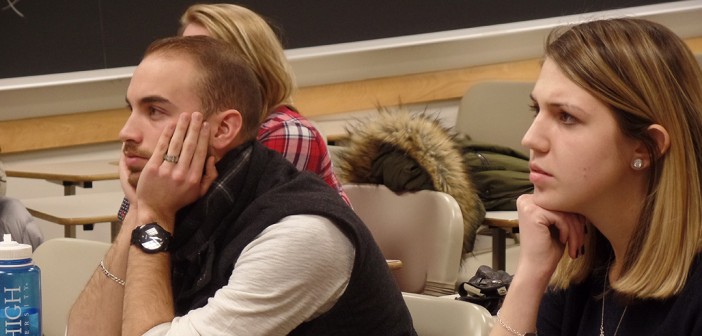A representative from the Crime Victims Council of the Lehigh Valley talked about the myths, stereotypes, and other topics concerning rape culture in today’s society Thursday night in Maginnes Hall.
The Lehigh Says NO MORE club, which spreads awareness of the issues of sexual assault and domestic violence and promotes action towards ending these issues, brought the representative in to speak to the students.
Emily Rieser, an outreach educator at the non-profit agency, presented a slideshow and several video clips giving facts about rape culture, its victims and perpetrators, bystanders and the views of society.
“I thought her information on rape culture shed a light on how college campuses act around rape, especially when she talked about rape jokes like ‘that test raped me’ and such,” Samantha Randall, ’18, said. “I have heard someone say that for real before, which makes it all the more worse.”
Rieser said the problem with rape culture is all too prevalent on college campuses, as shown by the countless stories told and news reports on how the school did or did not handle the situation. 85 colleges and universities in the United States are currently under investigation for mishandling claims of sexual assault.
Schools at any level often play into victim blaming, Rieser says. High school dress code guidelines limit what girls can wear to not “put ideas into boys heads.”
For example, when the national offices of the 16 sororities at University of Virginia discouraged attendance at fraternity parties, many people responded negatively. Even though the national organizations enforced this because of safety concerns, some of the sorority women still felt as though they were being blamed for the rapes.
“A lot of universities don’t take rape or sexual assault as seriously as they should and perpetuate this idea of putting the responsibility, blame and shame on the victim while offering no serious consequence to the perpetrator,” Emily Raab, ’15, the president and founder of Says NO MORE, wrote in an email. “I think this is an issue that needs to be changed and needs to be handled much differently because the message these schools send in cases like this is that rape isn’t a serious crime, that a victim should feel hesitant to even report their assault, and that ultimately it’s the victim’s fault and problem.”
Rieser says that victim blaming, illustrated by the supposed importance of women’s prevention methods such as the rape whistle and the newly developed drug detecting nail polish, is an issue that women are now fighting. If the women weren’t wearing revealing clothes, drinking too much, or flirting with a man, the rape would not have happened, victim blaming suggests.
“We are placing most of the blame on women, but there should also be a balance in responsibility where the men learn not to rape,” said Miranda Reyes, ’16.
Reiser said the media plays a crucial role in how the rest of the society views rape. They attack the victim, emphasizing what they were doing before the attack, such as drinking, while protecting the perpetrator instead.
The media often even questions the victim’s motives for coming forward. According to Rieser, only about 2 percent of the offenders accused of rape are accused wrongfully.
In mainstream media, Rieser said that women are portrayed more as objects to look at, rather than people.
“When the media reports on powerful women, such as politicians, they report on their fashion and features, further objectifying them,” Rieser said.
Rieser also emphasized the importance of a bystander taking part in stopping the crime. She described different kinds of bystanders, taught different intervention strategies, and showed a video to illustrate how a rape could be prevented.
“I thought that the information on bystanders was particularly important,” Randall said. “If the presentation was given to the general student body who don’t know as much about rape culture it would really cut down on how students react when faced with a situation like those in the videos.”






Comment policy
Comments posted to The Brown and White website are reviewed by a moderator before being approved. Incendiary speech or harassing language, including comments targeted at individuals, may be deemed unacceptable and not published. Spam and other soliciting will also be declined.
The Brown and White also reserves the right to not publish entirely anonymous comments.